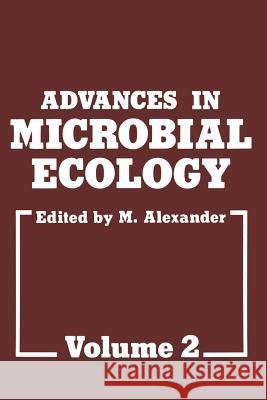Advances in Microbial Ecology: Volume 2 » książka



Advances in Microbial Ecology: Volume 2
ISBN-13: 9781461582243 / Angielski / Miękka / 2012 / 297 str.
Advances in Microbial Ecology: Volume 2
ISBN-13: 9781461582243 / Angielski / Miękka / 2012 / 297 str.
(netto: 191,21 VAT: 5%)
Najniższa cena z 30 dni: 192,74
ok. 22 dni roboczych
Dostawa w 2026 r.
Darmowa dostawa!
The substantial and impressive changes in microbial ecology can scarcely be chronicled in a meaningful fashion, and a review series such as Advances in Microbial Ecology can thus not do justice to the numerous studies that have been published in recent years.
1 Principal-Components and Factor Analysis for the Description of Microbial Populations.- 1. Introduction.- 2. Adansonian Classification and Microbiology.- 3. Methods for Collecting Primary Data.- 3.1. Introduction.- 3.2. Multipoint Techniques.- 3.3. Choice of Tests.- 3.4. Data Collection and Storage.- 4. Factor Analysis for Describing Microbial Populations.- 4.1. Principal-Components Analysis and Factor Analysis.- 4.2. Mean Values for Test Variables.- 4.3. Correlation Matrix between Variables.- 4.4. Eigenvalues, Variance, and Communality.- 4.5. Rotated Factor Matrix.- 5. Applications of Factor Analysis in Environmental Microbiology.- 5.1. Introduction.- 5.2. Effect of Soil-Management Practices on Bacterial Populations.- 5.3. Effects of Chemicals on Bacterial Populations.- 6. Conclusions and Perspectives.- References.- 2 Limiting Factors for Microbial Growth and Activity in Soil.- 1. Introduction.- 1.1. Concept of the Limiting Factor.- 1.2. Application of the Limiting Factor Concept to Soil.- 1.2.1. Interactions between Environmental Factors.- 1.2.2. Alteration of the Range of Tolerance.- 1.2.3. Variations of Environmental Factors in Time and Space.- 1.2.4. Modified Concept of Limiting Factors.- 2. The Soil Habitat.- 2.1. Heterogeneous Distribution of Microorganisms in Soil.- 2.2. Heterogeneous Physical Nature of Soil Habitat.- 2.3. Microbial Diversity in Soil.- 3. Methodology for Study of Limiting Factors in Soil.- 3.1. Process Chemistry and General Microbial Indices.- 3.2. Indicators of Microbial Activity.- 3.2.1. Isotope Tracers.- 3.2.2. Acetylene Reduction.- 3.3. Indicators of General Microbial Numbers or Biomass.- 3.3.1. Direct Microscopy.- 3.3.2. Biomass Estimates by Indicator Chemical Constituents.- 3.4. Enumeration of Specific Microorganisms.- 3.4.1. Selective Media.- 3.4.2. Immunofluorescence.- 4. Major Limiting Factors.- 4.1. Energy.- 4.2. Light.- 4.2.1. Light Deficiency.- 4.2.2. Light Excess.- 4.3. Temperature.- 4.4. Water Tension.- 4.5. Oxygen.- 4.6. pH.- 4.7. Mineral Nutrients.- 4.8. Biological Factors.- 5. Factors Limiting Growth and Activity for Selected Processes.- 5.1. Nitrogen Fixation.- 5.1.1. Soil Physical-Chemical Factors Limiting Nodule Initiation.- 5.1.2. Soil Biological Factors Limiting Nodule Initiation.- 5.1.3. Intrinsic Factors Limiting the Endophyte.- 5.1.4. Prospects for Relieving Limitations to Nodule Initiation.- 5.2. Nitrification.- 5.2.1. Major Factors Limiting Nitrification.- 5.2.2. Research Approaches Needed.- 5.2.3. Nitrifier Diversity and Activity.- 5.3. Denitrification.- 5.3.1. Anaerobiosis.- 5.3.2. Energy and Electron-Yielding Substrates.- 5.3.3. Nitrate.- 5.4. Sulfate Reduction.- 5.4.1. Anaerobiosis.- 5.4.2. Energy and Electron-Yielding Substrates.- 5.4.3. Sulfate.- 5.5. Formation of Peats and Mor Horizons.- 6. Modeling Microbial Growth and Activity in Soil.- 6.1. Components of the Model.- 6.2. Operation of the Model.- 6.3. Treatment of Limiting Factors.- 6.4. The Model as an Investigative Tool.- References.- 3 Eco-Physiological Aspects of Microbial Growth in Aerobic Nutrient-Limited Environments.- 1. Introduction.- 2. Mechanisms of Adaptation to Low-Nutrient Environments.- 2.1. Regulation and Modulation of Substrate-Uptake Systems.- 2.2. Regulation of Metabolism of Nonlimiting Nutrients.- 2.3. Regulation and Modulation of Polymer Synthesis.- 2.4. Coordinated Regulation of Cell Synthesis.- 3. Bioenergetic Considerations.- 4. Transient-State Phenomena: Microbial Reactivity.- 5. Conclusions.- References.- 4 Role of Microorganisms in the Atmospheric Sulfur Cycle.- 1. Introduction.- 2. Microbial Production of Volatile Sulfur Compounds.- 3. Microbial Sources of Atmospheric Sulfur.- 3.1. Terrestrial Microorganisms.- 3.1.1. Microbial Activity in Soils.- 3.1.2. Microbial Activity in Manures.- 3.1.3. Microbial Activity in Phyllospheres and Rhizospheres.- 3.2. Aquatic Microorganisms.- 4. Microbial Sinks of Atmospheric Sulfur.- 5. Conclusions.- References.- 5 Microbiological Aspects of Regulating the Carbon Monoxide Content in the Earth’s Atmosphere.- 1. Introduction.- 2. Carbon Monoxide in the Atmosphere.- 2.1. Introduction.- 2.1.1. Units of Measurement.- 2.1.2. Methods of Investigating the CO Content of the Atmosphere.- 2.1.3. Transfer of Trace Gases in the Atmosphere.- 2.2. Distribution of CO in the Atmosphere.- 2.2.1. Carbon Monoxide in Urban Areas.- 2.2.2. Distribution of CO in “Clean” Atmospheres.- 2.3. Variations of CO Content in the Atmosphere.- 2.3.1. Secular Trend of CO Content in the Atmosphere.- 2.3.2. Regular Temporal CO Variations in the Atmosphere.- 3. Abiogenic Processes in the CO Cycle.- 3.1. Anthropogenic CO Production.- 3.2. Natural Sources and Sinks of Atmospheric CO.- 3.2.1. Liberation of CO by Oceans.- 3.2.2. Photochemical Reactions in the Atmosphere.- 3.2.3. Liberation of CO from the Interior of the Earth.- 3.2.4. Other Geophysical Sources.- 4. Role of Biological Agencies in Forming and Binding CO.- 4.1. Formation of CO by Living Systems.- 4.1.1. Production of CO by Animals.- 4.1.2. Formation of CO by Algae and Cyanobacteria.- 4.1.3. Formation of CO by Higher Plants.- 4.1.4. Production of CO by Bacteria.- 4.1.5. Conclusion.- 4.2. Fixation of CO in the Biosphere.- 4.2.1. Reaction with Hemoproteins.- 4.2.2. Fixation of CO by Higher Plants.- 4.2.3. Absorption of CO by the Soil.- 4.2.4. Fixation of CO by Nonspecific Microflora.- 5. Carboxydobacteria.- 5.1. History of Research.- 5.2. Characteristics of the Physiological Group.- 5.2.1. Isolation of Carboxydobacteria.- 5.2.2. Morphological and Cultural Characteristics.- 5.2.3. Growth of Carboxydobacteria under Autotrophic Conditions.- 5.3. Utilization of CO by Carboxydobacteria.- 5.4. Conclusion.- 6. Comparative Role of Different Factors in the CO Cycle.- References.- 6 Microbial Ecology of the Human Skin.- 1. The Environment.- 1.1. Introduction.- 1.2. Physical Features.- 1.2.1. Hair.- 1.2.2. pH.- 1.2.3. Temperature.- 1.2.4. Humidity.- 1.3. Availability of Nutrients.- 1.3.1. Sweat.- 1.3.2. Antibacterial Substances.- 1.3.3. Studies on Sebum.- 1.4. Location of Skin Flora.- 1.5. Microbial Adherence to Skin.- 1.6. Recovery of Microbes from Skin.- 2. Cutaneous Microflora.- 2.1. Taxonomy of the Cutaneous Cocci.- 2.2. Micrococcaceae.- 2.3. Staphylococcus aureus.- 2.4. The Taxonomy of Skin Coryneforms.- 2.5. Aerobic Coryneforms.- 2.6. Anaerobic Coryneforms.- 2.7. Gram-Negative Bacteria.- 2.8. Yeasts—Pityrosporum.- 3. Microbes in Their Habitat.- 3.1. Host Factors.- 3.2. Microbial Coactions.- 3.3. Ecological Genetics.- 3.4. Experimental Ecological Studies.- References.
1997-2025 DolnySlask.com Agencja Internetowa
KrainaKsiazek.PL - Księgarnia Internetowa









